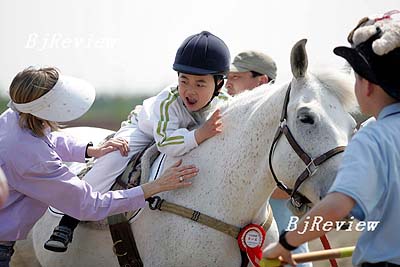|

The shine of the saddle leather contrasts nicely with the glint of steel stirrups and the chestnut sheen of the steed on giant hoardings shielding construction on an apartment complex in the Li Du.
From real estate in the decidedly upper crust Li Du on Beijing's northeastern reaches to the back covers of the country's fashion glossies, equestrianism is being associated with middle-class aspirations in modern China.
Horses are in fashion in Chinese advertising agencies using equestrian images to create an allure and win customers for consumer brands and auto companies in the fiercely competitive Chinese market place. In its latest nationwide advertising campaign, mobile phone maker Anycall features a helmeted Chinese show jumper, his immaculate white gloves laid on the nose of his silver steed, white jodhpurs contrasting with brilliant blue riding jacket.
Horses occupy a vaunted place in Chinese history. China's long heritage of equestrianism is evident in the gold-green replica Tang pottery horses on offer in markets across Beijing. The stirrup and breast-strap harnessing system were both invented in ancient China, when vast cavalries crossed the land enforcing the imperial edict. Horses of Shang Dynasty (1600-1100 B.C.) cavalries were entombed with their owners so as to be with them in the next life.
Much of the country's traditions of horsemanship have died out since the Tang Dynasty (618-907). European and U.S. riders have come to dominate the sport in recent centuries but today there's a resurgence of interest, as equestrian clubs open in major cities. Few in rapidly urbanizing China can afford a horse but the cost of riding lessons is affordable to increasing number of white-collar Chinese.
Instructors at clubs like Equuleus give one-hour lessons to wealthy Chinese and expatriates for an average 250 yuan per hour. Instructors at the 50-horse complex compete in national show jumping teams. Several trainers at Equuleus from Inner Mongolia and Xinjiang (where minority Mongols and Uygur peoples produce some of Asia's best riders and horses) ride for provincial show jumping teams at frequent competitions in Beijing and Shanghai.
Saturdays at Equuleus are noisy. Dozens of local Chinese boasting imported Italian breeches and German riding vests climb from SUVs and line up outside the clubhouse to mount horses. Most are beginners who take lessons intermittently. An increasing number persevere and learn to ride. Horses flinch at the whiz and "katchuk" of digital cameras as parents lean over white wooden railings to photograph their children being led on fat ponies around a circular training ring.
"Most of the new members are local," says Yang Fujun, an instructor. A staff of three coordinates students and instructors. In 2004 a single secretary sufficed. Then most members were expatriates, grabbing time on weekends away from the office.
Yang was among several of the stables' riders sent to Hartbury College in England. Photos in the clubhouse show the handsome 30-year-old posing with British students at the school's competition day. Hartbury awarded the club management four stars for "commitment to excellence in all aspects of their work."
The Han (206 B.C.-A.D. 220) and Tang dynasties expended vast sums on importing better horses from the West and from Arab lands for domestic breeding programs. Ironically it was the Yuan Dynasty (1279-1368)-a Mongol power built off the back of horses-that abandoned the imperial breeding programs, precipitating a shortage of quality horses that would weaken future dynasties.
Such shortsightedness has also hampered the local equestrian sports scene. Most of Equuleus' horses are retired racehorses flown from Hong Kong and Australia. More recently the club shipped warm bloods from Belgium and Holland, watched over by a Dutch trainer who travels regularly to the club to assist club instructors.
Equuleus plans to send its trainers to the equestrian events at the Beijing Olympics, which will be held in Hong Kong. The world's best bloodstock and their riders will be flown to China next year to compete at the Olympic Games. A new sand arena has been built in Sha Tin in Hong Kong to host jumping and dressage competitions, while a country club owned by Hong Kong Jockey Club in Sheung Shui will host the cross-country events. The spoils will likely go to foreign riders, for now. "China doesn't have good enough riders for this competition," said Yang. "Next Olympics, maybe."
The author is an Irishman living in Beijing | 